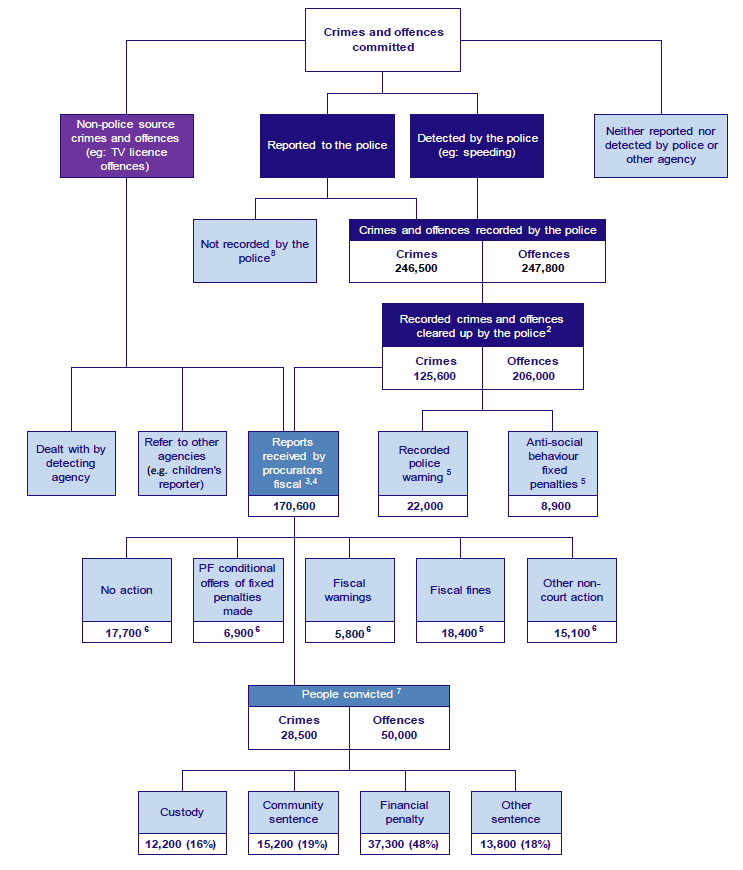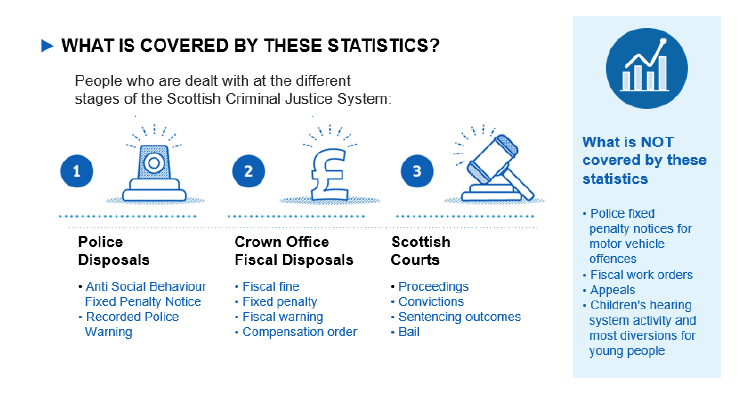Criminal proceedings in Scotland: 2018-2019
Statistics are presented on criminal proceedings concluded in Scottish courts and on a range of measures available as alternatives to prosecution, which are issued by the police and by the Crown Office and Procurator Fiscal Service.
Introduction
This bulletin presents statistics on the number of people dealt with by the Scottish Criminal Justice System. The statistics are derived from data held on the Criminal History System (CHS), a central hub used for the electronic recording of information on people accused or convicted of perpetrating a criminal act. The CHS is used and maintained by Police Scotland.
Changes made to this year's report
Changes have been made to this year's report as follows:
1. A new data management system has been employed to process the data provided in this year's publication. The transition to the new system identified some data processing errors present in the previous system, which were removed with the introduction of the new system. Fixes implemented to the 2017-18 and 2018-19 data have improved the quality of this data, however, it has not been possible to apply these fixes to the full time series for this release. We intend to present the fully corrected time series in the future.
2. These fixes are detailed in Annex B3. The changes affect less than 1% of entries in 2017-18 and 2018-19.
3. Several charts have been updated and reformatted to provide a clearer and more relevant illustration of the trends in the data. In a similar manner, a number of the Excel tables have been formatted differently so that raw numbers and proportions can be viewed in the same table by using a drop-down menu.
4. A breakdown of Record Police Warnings by offence type has been included for the first time.
5. An analysis of the punishment parts of life sentences and Orders for Lifelong Restriction has been published in a separate paper. This is derived from a separate data source.
Routes through the Criminal Justice System
Chart 2 depicts the various possible routes through the criminal justice system. People accused of a crime can be dealt with in a variety of ways: they can be dealt with directly by the police or the police can send a report to the Crown Office and Procurator Fiscal Service (COPFS) for review. COPFS can decide to:
- take no action
- to issue a direct measure, or
- to proceed against the individual in Court.
The number of people passing through the Criminal Justice System at a particular point in time depends in part on levels of crime made known to the police, as well as the measures that are available for use by criminal justice organisations at that time, as these can influence the point at which action is taken.
At each of the stages presented in Chart 2 information is logged on the CHS regarding the status of the accused. COPFS and the Scottish Courts and Tribunals Service (SCTS) provide updates on their own systems which are fed back electronically to Police Scotland's CHS. When an accused's case is given a final conclusion it is considered completed and the case is "disposed" of from the criminal justice system. The option used to complete the case is referred to as the method of "disposal", whether it is a court disposal used by SCTS or non-court disposal employed by COPFS or the Police.
Recorded Crime
The statistical publication, Recorded Crime in Scotland 2018-19, was published on 24th September 2019. The Recorded Crime publication and this Criminal Proceedings publication divide violations of criminal law into (a) crimes and (b) offences (see Annex D for further detail). This distinction is made only for statistical reporting purposes.
As shown in Chart 2, the total number of crimes recorded by the police in Scotland in 2018-19 was 246,480, 1% higher than in 2017-18 (244,504). The proportion of recorded crimes 'cleared up' by the Police increased by 1.5 percentage points from 49.5% in 2017-18 to 51.0% in 2018-19. A crime is regarded as 'cleared-up' where there is sufficient evidence under Scots criminal law to justify consideration of criminal proceedings.
The total number of offences recorded by the police decreased by 6% from 264,027 in 2017-18 to 247,791 in 2018-19. It should be noted that the number of offences recorded by the police generally tends to be affected more by Police activity and operational decisions than the number of crimes.
Whilst differences in counting methods (see Annex C) mean the figures in the Recorded Crime publication and those in this bulletin are not directly comparable, a crime or offence only comes to the attention of COPFS for consideration for prosecution once it has been recorded as such by the police, so recorded crime figures will have some influence on the number of prosecutions and convictions in Court.

1. Figures rounded to the nearest 100, and based on activity during 2018-19.
2. Crimes recorded in 2018-19 may not be cleared up or dealt with until 2019-20 or later.
3. A report to the procurator fiscal may involve more than one crime or offence and more than one alleged offender.
4. Reports to the fiscal on non-criminal matters such as sudden deaths, are not included in this total.
5. Number of people from CHS, Recorded Police Warning also includes 33 Formal Adult Warnings.
6. Number of cases; Data from Crown Office.
7. Figures for people with a charge proved count the number of different proceedings in which a person is convicted. People may be convicted of multiple charges in one proceeding, but this is counted as one person convicted per proceeding.
8. It may be deemed that an incident does not warrant recording e.g. if there is a lack of evidence that a crime was committed.
A number of outcomes may result in subsequent prosecutions or referrals to other agencies, for example if a condition such as payment of a fixed penalty is not complied with. For simplicity, these pathways are not shown in the diagram.
Police disposals and referrals
Chart 2 also shows that following a crime being cleared up, Police Scotland will either send a report to COPFS to decide what action should be taken or will deal with the case directly. Section 15 of this report contains statistics on the following non-court disposals available to the police when dealing with a case directly:
- Recorded Police Warnings (RPW) were introduced on 11th January 2016 to deal with a wider range of low level offences. A warning can be issued on the spot, or a notice issued retrospectively. This scheme replaced and extended Formal Adult Warnings.
- Anti-Social Behaviour Fixed Penalty Notices (ASBFPNs) as provided for in the Antisocial Behaviour etc (Scotland) Act 2004 for a range of offences including drunken-related behaviours and playing loud music; and
- actions which are used specifically for juveniles (aged 8 to 17) such as Restorative Justice Warnings and Early and Effective Interventions (EEI).
There are further options available to the police that we are not able to provide data on such as conditional offers of a fixed penalty notice for moving motor vehicle offences.A full listing of the range of disposals available can be seen in Annex D.
COPFS disposals and referrals (Section 16)
In 2018-19, COPFS received 170,575 criminal reports (from the police and other specialist reporting agencies), a decrease of 4% compared with 2017-18 (177,801). Where there is sufficient evidence and it is in the public interest to take action, prosecution in court is only one of a range of possible options the Procurator Fiscal has for dealing with people they have received a report for and, where appropriate, they may issue a direct measure. Statistics for the following non-court disposals are included in this publication:
- Fiscal fines of between £50 and £300
- Compensation orders of up to £5,000
- Fiscal warnings, and
- Fixed penalties of between £50 and £300, generally issued for motor vehicle offences.
There are further actions that the Procurator Fiscal can take that are not included in this report such as diverting cases to social work and other agencies and referrals to the Scottish Children's Reporter Administration (SCRA).
A full listing of the range of disposals available can be seen in Annex D.
Court disposals
The majority of statistics in this publication provide information on criminal cases brought to court and are contained in Sections 1 to 14. The outcomes possible for the person proceeded against are:
- the person is convicted, either after pleading guilty or being found guilty after evidence has been heard in Court
- the person is acquitted following a not guilty verdict
- the person is acquitted following a not proven verdict, or
- the person has their plea of not guilty accepted by the prosecutor or the case against them is deserted i.e. the Crown decides no longer to proceed with a prosecution at that time (though they may in some cases decide to prosecute at a future date).
Comparability with other statistics
Please note that the statistics presented in Chart 2 are taken from multiple data sources which are not strictly comparable, and there is no direct relationship between the number of crimes and offences recorded by the police and the number of follow-up actions taken by other agencies within the criminal justice system. For example, in the recorded crime statistics a single crime or offence recorded by the
Police may have more than one perpetrator, each of whom would be counted separately in the criminal proceedings statistics. There are also some offences included in this bulletin, such as failure to pay a television licence, which are reported directly to the procurator fiscal by specialist reporting agencies such as TV Licensing and therefore are not included in the police recorded crime statistics.
There are other comparability issues in that crimes or offences recorded and cleared up by the Police may not be processed by the Procurator Fiscal or the Courts in the same year as they were recorded. There is also the possibility that the crime or offence recorded by the police is altered by the Procurator Fiscal during the marking process.
For full details of comparability issues please see the relevant sections in Annex C.

Contact
Email: peter.malek@gov.scot
There is a problem
Thanks for your feedback